Scottish contractor builds custom harvesting business in Australia
It takes a brave man to up sticks and move his farm contracting operation to the other side of the world for a fresh start, but that’s exactly what Graeme Wright did back in 2002.
Fast forward 15 years and he is now running Sunshine Ag Services, a contract harvesting outfit that cuts up to 3,500ha of combinable crop across three Australian states.
He grew up on his parents’ 230-head dairy unit in Wigtownshire and, after a brief stint studying engineering at Barony College, he returned home to start his own general farm contracting business at just 18.
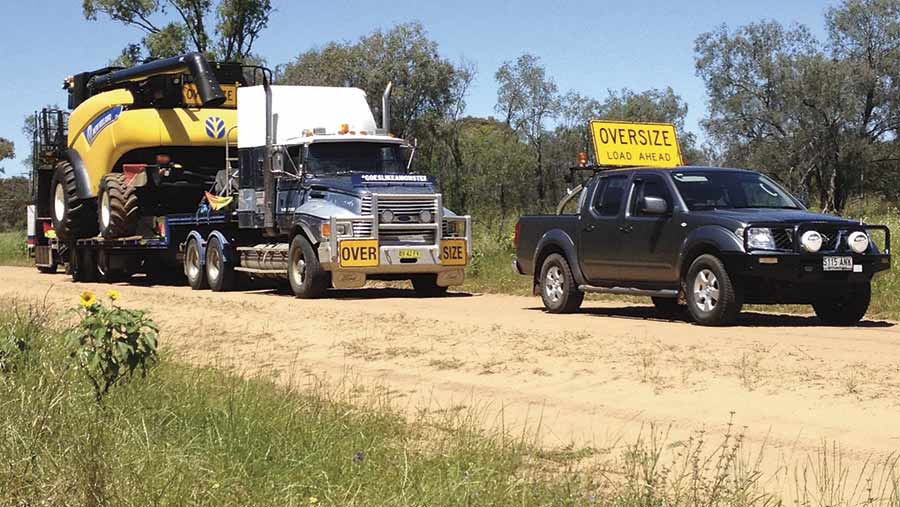
In 1998, he travelled to Australia for a month but ended up staying three months and doing some work on a fellow Scotsman’s farm in Queensland. After another holiday in 2002, he had made up his mind to sell the business back home and set up in Oz.
See also: What you need to know: farm contracting terms and conditions
Interstate run
Mr Wright’s route into custom harvesting started in 2003 when he picked up a job with a Naracoorte-based South Australian farmer, who also ran an interstate contracting business running four John Deere machines.
Starting in northern New South Wales in early October and heading south, the fleet split with two machines returning home for harvest and the other pair picking up extra work as they made their way through the grain belt back to South Australia.
Although continuing the same harvest run between October to February, he went self-employed which allowed him to pick up a variety of jobs out of season and from mid-February to mid-March he was on a grape harvester at a local vineyard.
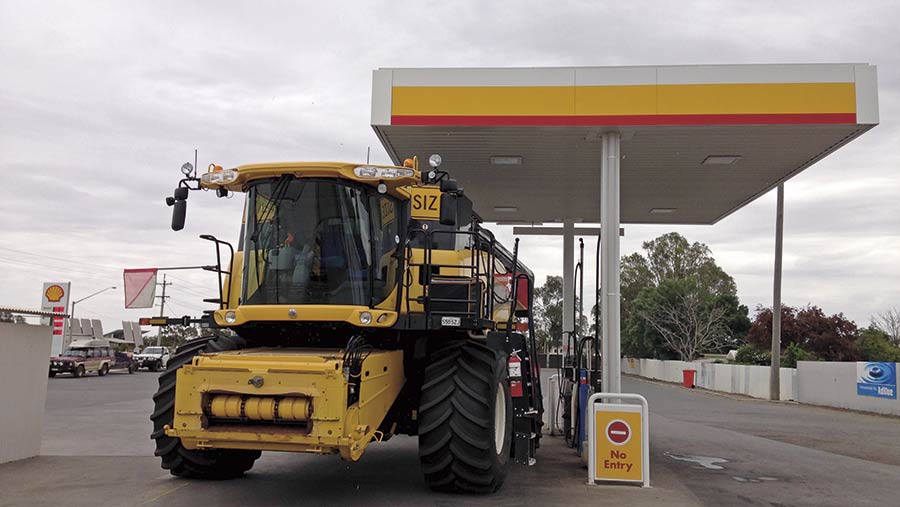
He then jumped back in a combine cab for the lucerne harvest, before driving an air-seeder to get the next season’s cereal crops in the ground.
After seeding he would then drive 3,000km to Darwin to drive excavators until the end of September, before returning home to drive a “B-Double” truck.
New company
An opportunity arose to go into partnership with a former employer at a time when the demand for contracting was picking up after several years of drought that forced many Australian contractors out of business.
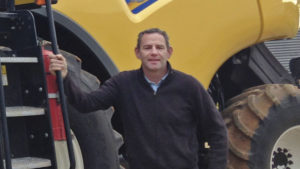
Graeme Wright
Sunshine Ag Services, Mintaro, South Australia
- Business type: Contract harvesting
- Area covered: 3,200-3,500ha annually
- Crops: Cereals, oilseed rape, pulses, clover seed, grass seed
Kit List
- 2012 New Holland CR 9090 harvester
- 2012 45ft Honeybee Air Flex draper header with quad axle trailer
- Compare 100CFM air compressor
- 2003 Mitsubishi Canter service truck
- 2011 Navara ST dual cab pickup
A new company was formed, which hired Mr Wright’s partner’s New Holland CR 960 and John Deere 9770 and the business continued harvesting in New South Wales, Victoria and South Australia for existing customers and picked up new work.
The following season the CR 960 was replaced by a New Holland CR 9090 with 40ft MacDon front, which ran for two seasons until the partnership ended.
“I bought the CR 9090 and traded the MacDon front for a 45ft Honey Bee AirFLEX Draper front, as the MacDon wasn’t big enough the capacity of the combine,” explains Mr Wright.
“Now with my ability to cover a large area quickly and contacts across the country, I’ve secured a steady stream of work.
“Farm sizes vary from small 80ha family properties to large corporate farms up to 16,000ha, so I’m sometimes the sole contractor or one of many – the most [combines] I’ve worked with is 15,” he adds.
Challenges
While the business is healthy, it doesn’t come without its challenges and Mr Wright says lack of rain through the cropping season is his biggest fear as reduced yields limit his workload.
“Australian summers are not always as hot, sunny and arid as some might believe and summer rains can also make the harvest run extremely painful as machines stand still waiting for it to dry out.”
“The long distances involved between jobs and being away from my new wife and friends is also a downside, but the different characters I meet and the relationships with long-standing clients that are now good friends make it all worthwhile.”
Despite having enough work to keep two combines busy, Mr Wright intends to continue running one machine for the foreseeable future.
It would be a significant investment and needs a skilled full-time driver capable of working alone – a rare commodity in Australia.
Life on the road for an Aussie harvest contractor
Travelling huge distances and working in some vast and unforgiving environments can be tough on both the machines and operators. Farmers Weekly posed Graeme Wright some questions on his kit and what life is like on a long run through the Aussie outback.
What machine are you running?
A 2012 New Holland CR 9090, 45ft Honeybee AirFLEX Draper front with upper crossover auger fitted, which enables me to harvest beans and direct head oilseed rape by eliminating any trouble getting the crop to feed.
It also has 4cm accuracy Trimble auto steer and yield mapping. It’s on single tyres rather than duals, so it is easier to truck and requires just one escort vehicle.
Why did you go for New Holland? Would you buy another?
It has unmatched capacity, with the twin rotor threshing system and self-levelling sieves and it’s easy to set up when changing between crops.
There is also great back-up from local dealers. I am also a big fan of Claas machines and would happily have one, but where I am working there are no close dealerships and that is a major factor for me.
I am currently getting a quote on a new CR 9.90 with auto steer, yield mapping, double folding unloading auger and, hopefully, telematics.
For the hours I am doing it makes sense to run a younger machine. I will keep my current Honey Bee front, as it’s quite simply the best I have operated.
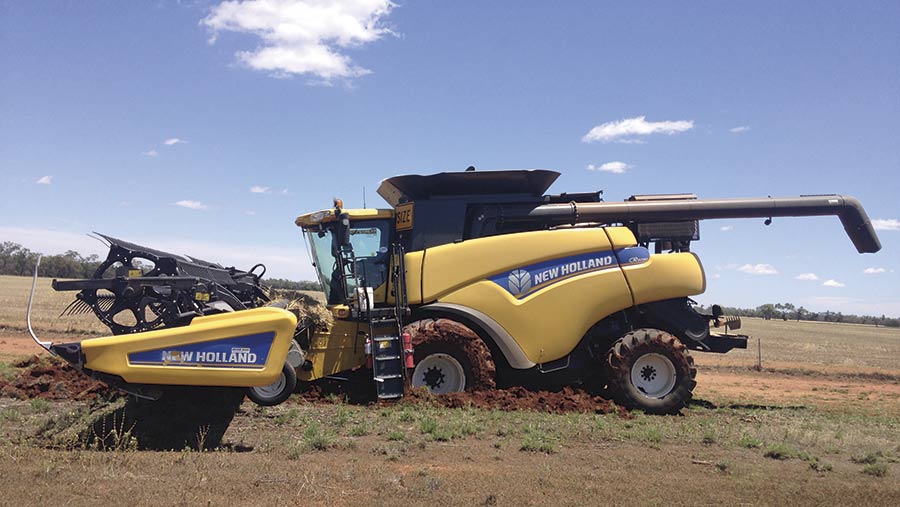
What else have you got in the fleet?
I have a Nissan Navara Dual Cab ST Ute and a Mitsubishi Canter service truck and both are fitted with oversize signs for road transport escorting duties. I also carry a 100 CFM diesel air compressor, mounted on the comb trailer.
What is on board the service truck?
It’s a bit old school, but 100% reliable. I cannot emphasize enough the role it plays in the day-to-day running of the business both at home and away.
It came with a fully enclosed lockable body, but I fitted shelving, lighting, tool boxes, 8KVA generator, mig welder, air compressor, Stihl blower, oxyacetylene gas bottles and loads of powered and unpowered tools, pullers, slide hammer and nuts and bolts.
It doubles as a bedroom and kitchen when needed, with spaces for the swag [outdoor sleeping bag], microwave, kettle, toaster and electric grill, as well as the 80-litre Engel fridge/freezer and 100 litres of fresh water. It has been my home away from home many times.
I also carry every single spare belt for the machine, fuel filters, two knife heads, knife guards, knife sections, a roll of draper belt and heaps of bearings, electrical plugs, spare chains, oils and coolant.
What tools couldn’t you do without on the road?
The most important thing in any toolbox in Australia is a can of fly repellant, sunscreen and a cold bottle of water.
Without these three essentials, you will go slightly mad within the first two minutes of any servicing and be that busy trying to swat flies you can forget what you are fixing.
What is the biggest breakdown you’ve had?
When recently bringing the header home at the end of the season, the main gearbox went 60km from home.
The local dealer then organised a low loader to pick up the combine and take it to a dealership, but unfortunately the truck driver hit a tree and smashed the lights, mirrors and roof on the left-hand side of cab in transit. Thankfully it was covered by the insurance.
Being such a vast country, are parts and service a problem?
Yes – trying to get dealer support as a contractor when away from home can be difficult, as we are less of a priority and often means we drive hundreds of kilometers to get parts.
Poor phone signal contributes to the challenges, too. On two occasions this season I had issues with AdBlue and each time it took two days to get somebody out to solve the problem.
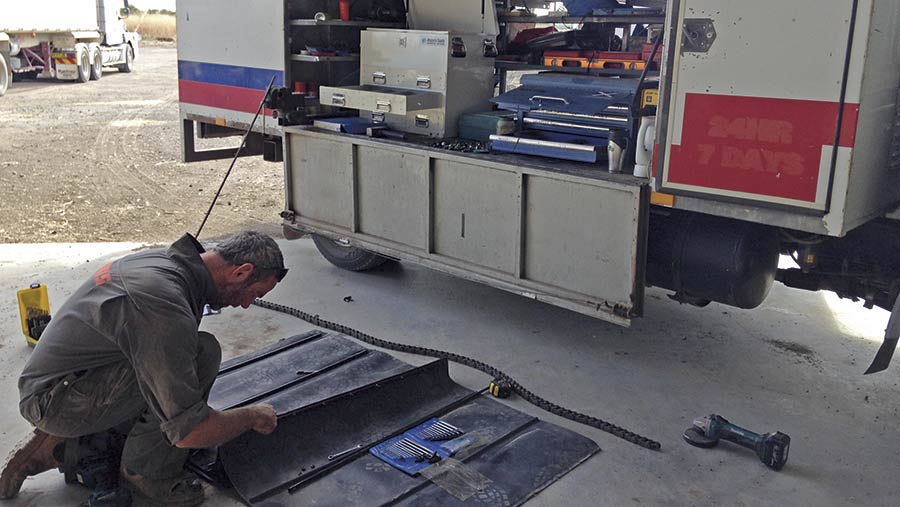
What’s the most serious repair you’ve carried out yourself?
I haven’t had to undertake anything too major myself. I do all the pre-season servicing but leave the electrics, gearboxes and all things technical to trained mechanics.
My philosophy is preventative maintenance in the winter months and this seems to be paying off as in the three years I have driven this machine I’ve only had to call out a mechanic twice.
It’s a lot easier to replace something at home in the workshop rather than wait until it breaks in the middle of a paddock 1,400km from home on a 42C day.
Biggest machinery mistake?
While parking a brand-new John Deere header on a levy bank out the way of the floods, I was in a wee bit of a rush to get off the farm and head for Byron Bay on the coast before the rural dirt roads became impassable.
As I parked, the combine slid backwards in the mud into the path of a road train driven by a man possessed (also trying to get out before the rain arrived) and it collected the spreader plate on the chopper and ripped it clean off.
How many kilometres have you put on the clock in a season?
When I was working as part of a four-machine team we were each doing about 4,000km/year. I did 450km on the road one day in a combine, then harvested all night until lunch the next day. It kept the farmer happy and we went back there for quite a few more years.
Any funny tales from out on the contracting run?
While driving through Walgett in New South Wales, I was following a fellow Scotsman in another combine and local Aboriginal children were peeing in bottles and throwing them at me, giving rude gestures and generally being very unfriendly.
A few hours later when we had stopped for the night, I asked my mate if the same thing had happened to him as he passed through, to which he replied, “no they were all waving at me and kicking the rugby ball about”. We had a beer and laughed about it.
It wasn’t until three days later when we were fitting extensions on his grain tank that we found a rugby ball at the bottom of the tank.
Apparently kicking balls over the top of harvesters and road trains is a popular pastime during the harvest run.
I also stopped in the Goolgowi pub one night bringing a combine home. It was torrential rain and every contractor, farmer and truck driver in the district were there having a big night, when someone let a piglet covered in oil and grease loose in the front bar. The ensuing mayhem was hilarious.
Favourite pub?
The pub at the town of Hebel on the Queensland/New South Wales border. It’s a real no frills corrugated iron outback pub with dirt on the floor and the walls decorated in old hats, boots and everything else in between.
A few years ago, they would only let you drink out of a stubby (bottle), as the cat was notorious for urinating on the glasses.

